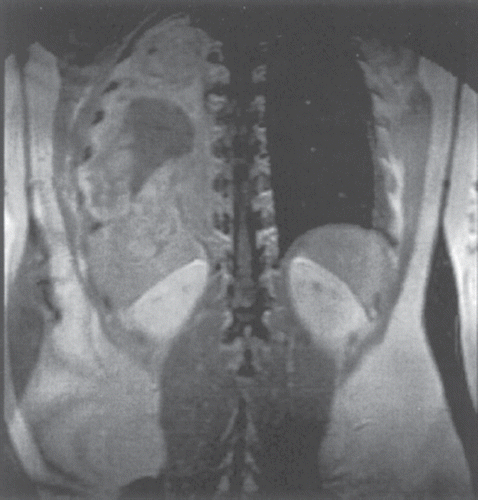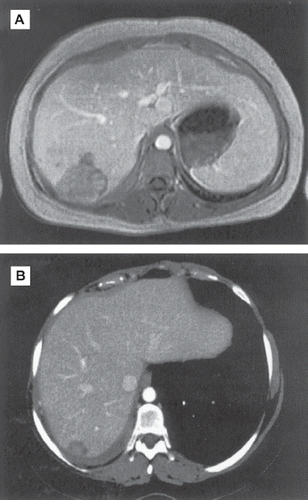To the Editor,
Case-reports on pulmonary blastoma in adult are exceptional. Due to its rarity, there is currently no treatment guideline, especially concerning the roles of chemotherapy and radiotherapy. We report a case of a young woman with biphasic pulmonary blastoma experiencing a dramatic response to doxorubicin plus ifosfamide regimen followed by radiotherapy.
Case report
A 22-year-old woman presented in June 2006 with a massive hemoptysis, revealing a large pulmonary right tumour. An urgent right pneumectomy was required with a pericardiectomy extended to the left auricle. Brain, chest and abdominal CT-scan and 18F-fluorodeoxyglucose (FDG) Positron Emission Tomography (PET) did not reveal metastatic extension. The initial histopathology report showed a 12 cm pulmonary blastoma biphasic subtype with no lymph node involvement and the resection was complete. A second histological examination confirmed the pulmonary blastoma diagnosis, well-differentiated with rhabdomyoblastic, chondroid, and osteoid differentiation. As the margins were clear, no adjuvant treatment was offered. On November 2006, CT-scan, PET scan and liver MRI showed a massive local recurrence with liver extension through diaphragm (, size 44 mm x 39 mm). The first-line treatment consisted of six cycles of combined chemotherapy (Ifosfamide 2.5 g/m2 on day 1 plus Doxorubicin 20 mg/m2 once daily for three consecutive days every 21 days with lenograstim support d6 to d13). Successive tumour assessments demonstrated major tumour shrinkage. After the sixth cycle, the size of the residual tumour was 21 mm x 14 mm (). The patient then received two additional cycles of doxorubicin (70 mg/m2/d q3wks) followed with stereotactic radiotherapy on the residual tumour (40 Gy). At the end of radiotherapy, the largest size of the residual mass was 11 mm without FDG-fixation. Nevertheless, a second local relapse with thoracic vertebra and scapula involvement was diagnosed in May 2008. The patient received three successive ineffective lines of chemotherapy (Carboplatin + Vincristine/ Cyclophosphamide + Actinomycine-D/docetaxel + gemcitabine). She died in November 2008.
Discussion and literature review
Pulmonary blastoma is a rare tumour. On the histological examination, it is characterised by the presence of two or biphasic malignant and immature cellular components: epithelial and mesenchymal [Citation1–3]. It appears like a first trimester fetal lung. The mesenchymal cellular component is represented by round or oval, rarely fusifom, shaped cells, with a high mitotic index and scattered in a myxoid stroma. It can demonstrate either rhabdomyoblastic (with desmin and myogenin expression in immunochemistry), chondroid or osteoid differentiation [Citation4]. The epithelial component consists of glandular structures with columnar cells. The p53 protein is generally overexpressed [Citation5].
The differential diagnoses that can be considered are: the carcinosarcoma (with an adult type for the mesenchymal component), the fetal adenocarcinoma of the lung (benign tumour with a poor myofibroblastic stroma and a low mitotic index) and the pleural pneumoblastoma (monophasic tumour with no epithelial component).
Most cases of pulmonary blastoma are diagnosed in children. Paediatric oncology guidelines concerning solid pneumoblastoma treatment recommend large surgery, adjuvant radiotherapy to sites with residual disease and neoadjuvant or adjuvant chemotherapy with six cycles of IVADo regimen (Ifosfamide + vincristine + Actinomycin D + doxorubicine) [Citation1].
Adult pulmonary blastoma is an exceptional disease. Surgery is also the cornerstone of curative intent treatment. Relevance of adjuvant chemotherapy and adjuvant radiotherapy are still debated. Further prospective studies are required. In advanced disease, there is no standard chemotherapy regimen. The following regimens provided objective response: doxorubicin plus ifosfamide, CCNU, cyclophosphamide, vincristine, VP-16 [Citation6] and cisplatine plus etoposide [Citation7]. In the present case report, the doxorubicin plus ifosfamide regimen combined with a sequential radiotherapy provided substantial partial response. The disease control was transient.
As a consequence of the rarity of this disease in adult, there is no recommendation for the treatment of such malignancy. A prospective database is warranted to better identify the impact of adjuvant treatment, to better define the most effective regimens in advanced disease and also to better understand the carcinogenesis of this rare tumour and to identify a molecular pathway that may improve their treatment in a targeted manner.
Declaration of interest: The authors report no conflicts of interest. The authors alone are responsible for the content and writing of the paper.
References
- The International Pleuropulmonary Blastoma Registry. Available from: http://www.ppbregistry.org/
- Koss M, Hochholzer L, O'Leary L. Pulmonary blastoma. Cancer 1991;67:2368–81.
- Travis W, Branbilia E, Müller-Hermelink H, Harris C. World Health Organization Classification of tumors. Pathology and genetics of tumors of the lung, pleura, thymus and heart. Lyon: IARC Press; 2004.
- Robert J, Pache JC, Seium Y, De Perrot M, Spiliopoulos A. Pulmonary blastomas: Report of five cases and identification of clinical features suggestive of the disease. Eur J Cardiothorac Surg 2002;22:708–11.
- Bodner SM, Koss M. Mutations in the P53 gene in pulmonary blastomas: Immunohistochemical and molecular studies. Human Pathol 1996;27:1117–23.
- Nissen MH, Jacobsen M, Vindelov L, Olsen J, Rorth M. Pulmonary blastoma: Remission with chemotherapy. Eur J Respir Dis 1984;65:377–9.
- Bini A, Ansaloni L, Grani G, Grazia M, Pagani D, Stella F, . Pulmonary blastoma: Report of two cases. Surg Today 2001;31:438–42.

